Abstract
This research investigates the impact of wood-based biochar on the engineering properties of medium plasticity clay obtained from Perryville, Maryland. The clay was amended with biochar at volumetric contents of 3%, 6%, 9%, 12%, and 15% and subjected to a comprehensive suite of index and classification, compression, and shear strength laboratory tests. Results indicate that increasing biochar content leads to higher liquid limits and plasticity indices, a decrease in dry unit weight, and a higher optimum moisture content. Compression tests revealed increased compressibility and final void ratio with higher biochar content, likely due to biochar’s porous structure. Direct shear tests showed consistent improvements in shear strength parameters, including increases in both the internal friction angle and cohesion. Unconfined compression tests also demonstrated higher strength and ductility in biochar-amended samples. These findings support the potential of wood-based biochar as a sustainable and effective soil amendment for improving the geotechnical performance of clayey soils.
1. Introduction
Rapid urbanization and the expansion of infrastructure networks—including roads, railways, tunnels, levees, and foundations—have increased the demand for construction-ready land. However, suitable sites with favorable geotechnical conditions are becoming scarce [], often necessitating construction on problematic soils, particularly those containing high proportions of clay minerals. These fine-grained soils present several geotechnical challenges, such as low permeability, poor bearing capacity, and significant volume changes due to moisture fluctuations, all of which can compromise the stability and longevity of built structures.
The presence of fine particles—particularly clay—within expansive soils has been found to increase swelling potential in proportion to the amount of fine material present []. Clay minerals are electrochemically active, extremely small crystalline particles formed through the chemical weathering of rock-forming minerals. These particles are typically less than 1 μm in diameter and have a flake-like structure composed of repeating atomic layers [].
Traditional soil stabilization techniques—such as lime treatment, cement mixing, or fiber reinforcement—have proven effective but are often expensive and environmentally taxing. In response, there has been growing interest in sustainable alternatives, such as nano clay [], Xanthan gum [], and biochar, a carbon-rich byproduct produced through the pyrolysis of organic biomass under limited oxygen conditions [,,,]. Biochar possesses several properties beneficial to geotechnical applications, including high porosity, low density, large surface area, and a strong water retention capacity.
This study explores the feasibility of utilizing wood-based biochar as a sustainable amendment to improve the engineering behavior of medium plasticity clay. Soil Reef PURE Biochar, sourced from residual hardwood, with a Carbon Ratio of 82% was used in this study. Laboratory tests were conducted on clay samples amended with varying biochar contents (3% to 15% by volume) to assess changes in key geotechnical parameters, including compaction behavior, compressibility, shear strength, and unconfined compressive strength. By analyzing the performance of biochar–clay mixtures, this research aims to contribute to the development of eco-friendly solutions for soil improvement in geotechnical engineering.
2. Historical Use of Biochar as a Soil Amendment
Biochar is an environmentally sustainable soil amendment produced through a process known as pyrolysis. This involves heating biomass in a low- or no-oxygen environment at temperatures typically ranging from 200 °C to 700 °C [,]. During pyrolysis, organic material is converted into a stable form of carbon—biochar—which resists decomposition and the release of carbon into the atmosphere []. The characteristics of biochar can vary depending on the type of feedstock used. For example, biochar derived from food waste tends to contain more labile carbon and less aromatic structure, resulting in lower stability. In contrast, biochar produced from wood, grass, or straw is more highly carbonized, with aromatic structures that enhance soil stability []. Similarly, biochar generated from agricultural or forestry residues is typically considered highly stable in soil [].
In recent years, biochar has attracted increasing attention in geotechnical engineering as a soil stabilizer [,]. Its beneficial properties—such as high porosity, large specific surface area, low density, water-holding capacity, and nutrient retention—make it a promising material for ground improvement [,,]. Due to its high porosity, biochar enhances soil permeability, reducing water retention and mitigating the swelling behavior of expansive soils. The effects of biochar on the hydraulic conductivity of soils were investigated by numerous researchers [,,]. Beyond geotechnical applications, biochar is also widely used in carbon sequestration, contaminated soil remediation, and water and wastewater treatment []. Nakhli, Goy, Manahiloh and Imhoff [] investigated the spatial heterogeneity created when mixing biochar with soil, and its impact on the hydraulic conductivity of soil.
Bian, et al. [] observed that soil amended with biochar and high moisture content exhibited favorable geotechnical properties. Specifically, increasing the biochar content was associated with decreases in both the compression index and void ratio, indicating improved soil performance. Biochar also influences various physical and chemical aspects of soil behavior [,,,].
Biochar is highly porous, and it has a lower density than soil; thus, the application of soil amendment enhances porosity, pore size distribution, and hydraulic conductivity and reduces the density of soil [,,]. In addition, due to its high surface area compared to soil, adding biochar to soil results in an increase in soil-specific area [].
Lamprinakos and Manahiloh [] demonstrated that adding biochar to silty sand affects compaction behavior by lowering the maximum dry unit weight and increasing the optimum moisture content. Numerous studies have also confirmed that biochar can mitigate the swelling and shrinking of expansive soils while improving mechanical properties such as strength and stiffness [,,,,]. Villarreal and Wang [] identified two mechanisms through which biochar benefits expansive soils: (1) its superior water-holding capacity compared to clay minerals allows it to retain moisture more effectively, and (2) its high porosity increases soil permeability, thereby reducing expansion deformation.
Further evidence from Zhang, Jing, Chen, Wang and Zhang [] shows that biochar enhances soil structure and microbial activity by promoting aggregate formation, which positively influences hydraulic properties. Castellini, Giglio, Niedda, Palumbo and Ventrella [] similarly found that biochar increases hydraulic conductivity relative to unamended soils. Reddy, Yaghoubi and Yukselen-Aksoy [] indicated that the compressibility of soil decreases as the percentage of biochar content in soil increases, and it increases when the particle size of biochar decreases. This finding aligns with Zhang, Gu, Tang, Shen, Narala and Shi [], who reported that the presence of biochar reduces the compressibility of clayey soils due to its low-density characteristics. Additionally, Manahiloh, Kaliakin and Verdi [] observed that incorporating biochar into fat clay improves unconfined compressive strength, with higher biochar percentages leading to greater strength gains.
3. Materials and Methods
3.1. Test Clay
The test soil used in this study was a natural clay obtained from a borrow pit located in Perryville, Maryland, USA. Based on the Unified Soil Classification System (USCS, ASTM D2487 []), the material was identified as a medium plasticity clay (CL). The specific gravity of the soil solids was 2.69, determined according to ASTM D854 [].
The Atterberg limits, determined per ASTM D4318 [], were: Liquid Limit (LL) = 49.8%, Plastic Limit (PL) = 25.1%, and Shrinkage Limit = 16.76%. The grain size distribution, determined via hydrometer analysis following ASTM D7928 [], confirmed that the material was composed primarily of clay- and silt-sized particles with minimal sand fraction.
3.2. Biochar
The clay amendment used in this study was Soil Reef PURE Biochar, a wood-derived biochar produced from residual hardwood feedstock through slow pyrolysis under oxygen-limited conditions. The product contained approximately 82% fixed carbon and exhibited a highly porous, low-density, large-surface-area structure, which is beneficial for soil modification.
Before mixing, the biochar was oven-dried at 110 °C to remove residual moisture and then gently pulverized and sieved through a No. 40 (425 µm) mesh to achieve uniform particle size and ensure consistent mixing within the clay matrix.
3.3. Sample Preparation
The Test Clay was amended by Biochar at volumetric contents of 0%, 3%, 6%, 9%, 12%, and 15%. The predetermined quantities of oven-dried biochar and clay were thoroughly blended in a mixing pan to ensure homogeneous distribution. Each mixture was prepared at an initial gravimetric water content of approximately 30%, slightly above the optimum moisture content of the untreated clay, to facilitate compaction and specimen molding. The mixtures were then sealed in airtight containers for at least 24 h to allow uniform moisture equilibration prior to testing.
3.4. Experimental Program
A series of geotechnical laboratory tests were performed to evaluate the influence of biochar content on the engineering properties of the test clay. All tests were conducted in triplicate to ensure reproducibility. The experimental program included: Index and classification tests, including specific gravity (ASTM D854 []), grain-size distribution (ASTM D7928 []), and Atterberg limits (ASTM D4318 []); Standard Proctor compaction tests (ASTM D698 []); One-dimensional consolidation tests (ASTM D2435 []); Direct shear tests (ASTM D3080 []); and Unconfined compressive strength (UCS) tests (ASTM D2166 []) to assess peak compressive strength and strain at failure.
4. Results and Discussion
4.1. Index and Classification Tests
The specific gravity of the test clay was 2.69, and it decreased systematically with increasing biochar content (Table 1). The reduction followed a nearly linear trend, reaching 2.57 at 15% biochar (Figure 1). The decline reflects the low density and high porosity of the biochar, which, when blended with the denser clay minerals, results in a lighter soil-biochar matrix.

Table 1.
Specific Gravity Data.

Figure 1.
Specific Gravity vs. Biochar Content.
The Atterberg limits for both unamended and biochar-amended samples are summarized in Table 2. The liquid limit (LL) increased from 49.8% for the test clay to 56.0% at 15% biochar, while the plastic limit (PL) decreased slightly from 25.1% to 21.8%. Consequently, the plasticity index (PI) increased from 24.7% to 34.2%, indicating an expansion in the plastic range. This trend suggests enhanced water adsorption capacity and altered soil–water interaction due to the high surface area and hygroscopic nature of biochar particles. These findings align with those reported by Lamprinakos and Manahiloh [] and Zhang et al. [], who attributed similar behavior to the microstructural characteristics of biochar that facilitate increased moisture retention.

Table 2.
Atterberg Limits Data.
The presence of clay minerals in the soil contributes to its tendency to swell and shrink depending on moisture content. Plasticity refers to a physical characteristic of the interaction between clay and water. It can be quantified through various methods, including Atterberg limits, Pfefferkorn test, penetrometer, capillary rheometer, Brabender rheometer, and tension-deformation analysis []. The plastic behavior of soil is indicative of the presence and nature of clay minerals []. These plasticity characteristics significantly influence the geotechnical behavior of soils. According to Mitchell and Soga [], “the greater the plasticity, the greater is the shrinkage on drying (the lower the shrinkage limit).” Furthermore, they note that “the swelling and shrinking properties of the clay minerals follow the same pattern as their plasticity properties; that is, the more plastic the mineral, the more potential for swell and shrinkage.” Based on the Unified Soil Classification System (USCS, []), the soil was identified as a medium plasticity clay, as indicated in Figure 2 as “Test Clay.” To confirm the classification, the Liquid Limit test was repeated, as the initial value was near the threshold between medium and high plasticity. Since the average Liquid Limit remained close to 50%, the clay was classified as having medium plasticity.
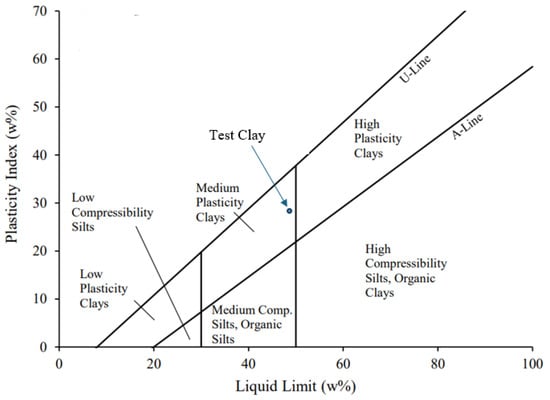
Figure 2.
Test Clay on the Plasticity Chart.
Since the test clay proved to be fine-sized, a Hydrometer Analysis was run to characterize its particle size distribution. The particle size distribution that was obtained for the test clay, following ASTM D7928 [], is shown in Figure 3.
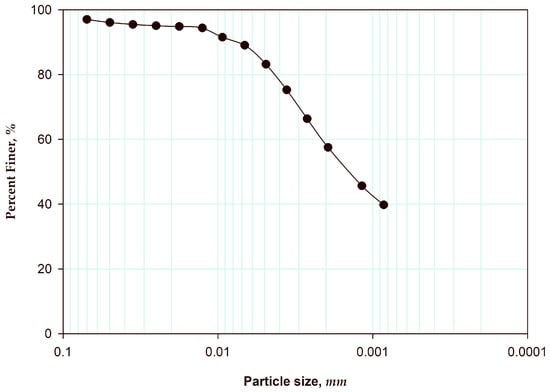
Figure 3.
Grain Size Distribution Curve of the test Clay.
4.2. Compaction Characteristics
The Standard Proctor compaction tests were performed on the test clay and mixtures containing 6% and 10% biochar (Figure 4). The results demonstrated a decrease in maximum dry unit weight with increasing biochar content and a corresponding increase in the optimum moisture content (OMC). Specifically, the test clay achieved a of 15.64 kN/m3 at an OMC of 23.25%, while the biochar amended samples exhibited lower densities and higher OMC values.
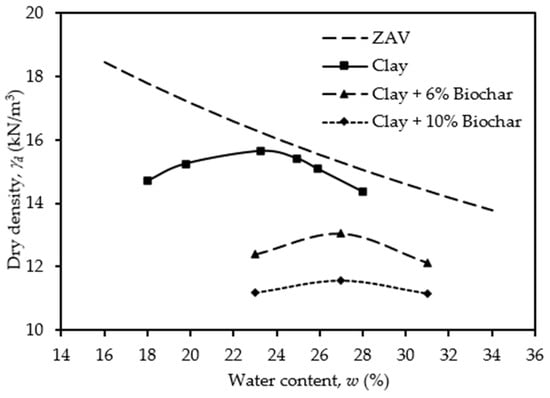
Figure 4.
Proctor Compaction Data.
This behavior is consistent with the intrinsic properties of biochar—low particle density and high water retention capacity—which influence the packing efficiency of soil particles. The porous biochar particles also tend to absorb part of the compaction energy, limiting particle rearrangement and leading to reduced dry densities. Similar findings have been reported in other studies involving biochar-amended soils [,].
4.3. Compression Behavior
The compressive behavior of the Test Clay and Clay–Biochar mixtures was assessed using a one-dimensional compression test. While compressive characteristics are conventionally determined, on undisturbed disk samples in accordance with ASTM D2435 [] using a Karol Warner consolidometer apparatus (sourced from Gilson Company Inc., Lewis Center, OH, USA), a customized setup, where the samples were prepared by remolding, was employed in this study.
All specimens were prepared at comparable water contents to ensure uniformity in initial conditions. The biochar content was systematically varied across samples, ranging from 3% to 15% by volume, with increments of 3%. Each specimen was subjected to a series of incremental vertical stresses: 97, 194, 388, 776, 1552, 776, 1552, 3104 kPa. Each load increment was maintained for a duration of one day to allow for full compression under that load before the subsequent load was applied.
Soil specimens were prepared with an initial gravimetric water content of approximately 30%, then compacted to conform to the dimensions of the consolidation ring. The precise initial moisture content was recorded prior to testing. Each specimen was placed within a fixed-ring consolidometer, enclosed between two porous stones to facilitate uniform vertical drainage. Full saturation was achieved by inundating the specimen with water throughout the testing period.
Consolidation tests resulted in the Compression and Swelling/Recompression Indices presented in Table 3. Both indices show trends of decreasing linearly as shown in Figure 5.

Table 3.
Compression and Swelling/Recompression Indices.
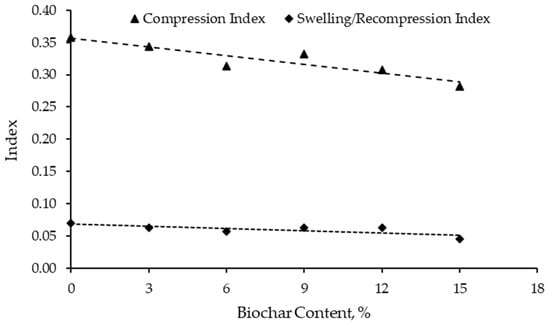
Figure 5.
Compression and Swelling/Recompression Indices vs biochar content.
A clear trend of increasing compressibility with higher biochar content was also observed. The percent compression was selected as a measure of the degree of compressibility in all specimens. It was calculated as the change in thickness of the sample divided by the initial thickness and expressed as a percentage quantity. For the Test Clay, it was 14.36%, whereas it increased linearly to 21.0% for Clay + 15% Biochar by volume. Figure 6 presents the results obtained for all specimens. This behavior is attributed to the porous and high-surface-area structure of biochar, which introduces additional voids within the soil matrix by trapping air and water, thereby enhancing the mix’s overall compressibility.
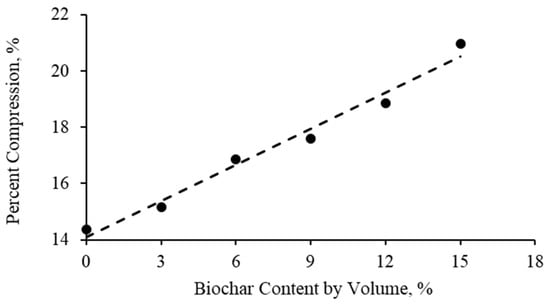
Figure 6.
Compression index vs. biochar content.
4.4. Shear Strength
4.4.1. Direct Shear Test
Drained direct shear tests were conducted under normal stresses of 50, 100, and 200 kPa. The corresponding failure shear stresses are summarized in Table 4, and the derived shear strength parameters are presented in Table 5.

Table 4.
Shear strength data.

Table 5.
Shear Strength Parameters data.
The internal friction angle () increased from 1.6° for untreated clay to 5.9° at 15% biochar, and the effective cohesion (c′) rose from 4.31 kPa to 22.50 kPa. This progressive enhancement indicates improved particle interlocking and bonding within the amended soil structure. The high specific surface area of biochar likely contributes to increased mechanical interparticle resistance and suction effects during drainage.
The shear stress–normal stress relationships (Figure 7) confirmed a linear increase in shear resistance with normal stress, while Figure 8, Figure 9 and Figure 10 illustrate the steady gains in , c′, and with biochar addition. Overall, these results demonstrate that biochar improves the drained shear strength of the clay matrix, an effect consistent with previous findings by Manahiloh et al. [] and Villarreal and Wang [].
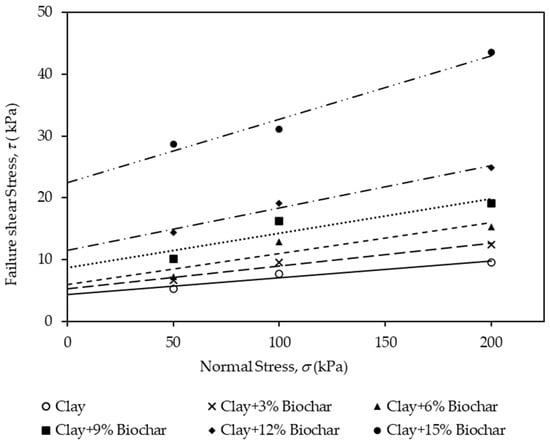
Figure 7.
Shear stress vs. normal stress at failure.
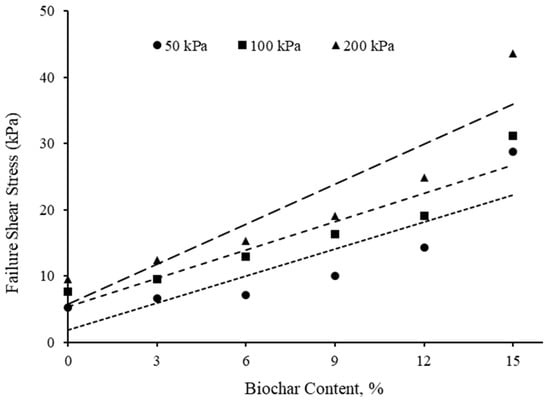
Figure 8.
Shear strength vs. biochar content.
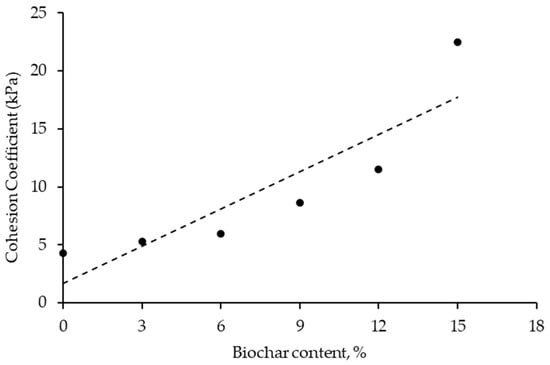
Figure 9.
Cohesion coefficients vs. biochar content.

Figure 10.
Friction angle vs. biochar content data.
4.4.2. Unconfined Compressive Strength
The unconfined compression tests were performed on cylindrical specimens (50 mm × 100 mm) at a strain rate of 1%/min. The stress–strain curves for representative samples are shown in Figure 11, and the peak unconfined compressive strength (UCS) and strain at failure values are listed in Table 6.
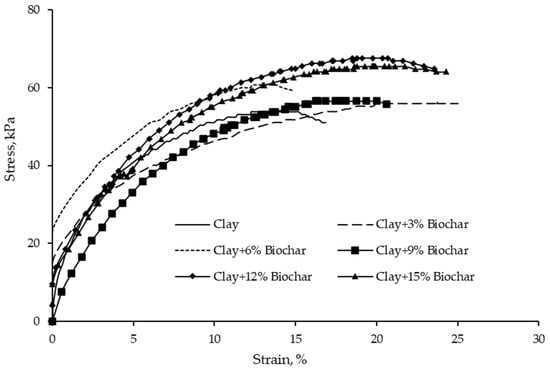
Figure 11.
Representative Samples (%ages show biochar content by volume).

Table 6.
Peak Strength Data.
The UCS increased from 53.78 kPa for untreated clay to 65.50 kPa at 15% biochar, reflecting a clear improvement in structural integrity (Figure 12). Moreover, the strain at failure increased from 12.26% to 21.12%, indicating greater ductility in biochar-amended specimens (Figure 13). These outcomes suggest that biochar enhances both the strength and deformability of the soil, likely due to improved particle bridging, increased interfacial bonding, and the ability of the biochar pores to accommodate deformation without abrupt failure.
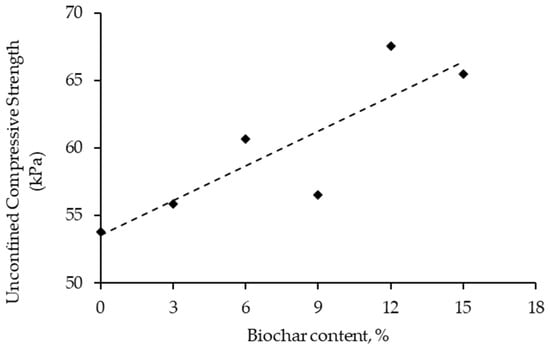
Figure 12.
Unconfined Compressive Strength vs. biochar content.
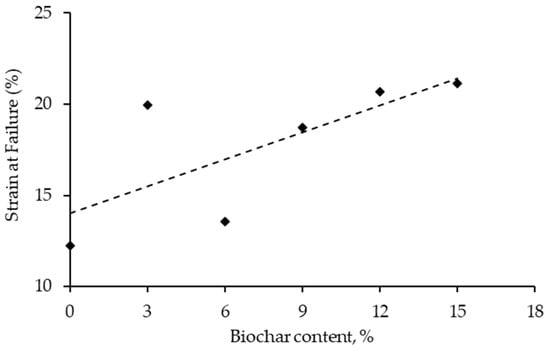
Figure 13.
Strain at UCS failure.
Similar improvements in compressive behavior have been observed in biochar-modified expansive and cohesive soils [,]. The enhanced ductility also points to the potential use of biochar as a stabilizing additive in applications where deformation control is critical, such as embankments and subgrade stabilization.
5. Conclusions
This study systematically evaluated the influence of wood-based biochar on the geotechnical properties of medium plasticity clay through a comprehensive suite of laboratory tests. Biochar was incorporated at volumetric contents ranging from 0% to 15%, and the resulting mixtures were assessed for changes in Atterberg limits, compaction characteristics, compressibility, shear strength, and unconfined compressive behavior.
The following are key findings from the investigation:
- Plasticity Behavior: The addition of biochar led to a consistent increase in the liquid limit and plasticity index, indicating enhanced water retention capacity and altered clay–water interactions. These changes are attributed to the porous microstructure and high surface area of biochar.
- Compaction Characteristics: Increasing biochar content resulted in a reduction in maximum dry unit weight and an increase in optimum moisture content. This trend is consistent with the low specific gravity and high-water absorption capacity of biochar, which influences the compaction response of the soil.
- Compressibility: Consolidation tests demonstrated increased compressibility with higher biochar content. This is likely due to the incorporation of porous biochar particles, which introduce additional voids and facilitate water retention within the soil matrix.
- Shear Strength Parameters: Direct shear testing revealed overall improvements in shear strength with biochar amendment. Both cohesion and internal friction angle increased with biochar content, suggesting that biochar enhances interparticle bonding and resistance to shear deformation under drained conditions.
- Unconfined Compressive Strength: UC tests indicated a general increase in both peak compressive strength and strain at failure with increasing biochar content. The results suggest that biochar not only improves strength but also imparts greater ductility, allowing the clay matrix to undergo larger deformations before failure.
Overall, the results demonstrate that wood-based biochar is a sustainable and technically effective amendment for improving the engineering properties of clayey soils. Its incorporation not only enhances soil strength, ductility, and compressibility but also advances environmental sustainability by closing the material loop through the reuse of waste biomass. Compared to energy-intensive chemical stabilizers such as lime and cement, biochar offers a low-cost, eco-efficient alternative that supports carbon sequestration and reduces embodied energy. These findings position wood-based biochar as a promising material for sustainable geotechnical applications, consistent with the principles of the circular economy. Future research should focus on assessing the long-term field performance of biochar-stabilized soils and investigating how variations in biochar feedstock type and production conditions influence their geotechnical behavior.
The authors acknowledge that the obtained observations should not be generalized as they deal with only one clay and one biochar type. The intent of this study is to get a feel for how a medium plastic clay behaves as it is mixed with varying biochar content. Also, it should be remembered that all specimens tested were remolded from a disturbed sample.
Author Contributions
Conceptualization, K.N.M., S.M.F. and E.D.; methodology, K.N.M., S.M.F. and E.D.; software, K.N.M., S.M.F. and E.D.; validation, K.N.M., S.M.F. and E.D.; formal analysis, K.N.M., S.M.F. and E.D.; investigation, K.N.M., S.M.F. and E.D.; resources, K.N.M., S.M.F. and E.D.; data curation, K.N.M., S.M.F. and E.D.; writing—original draft preparation, K.N.M., S.M.F. and E.D.; writing—review and editing, K.N.M., S.M.F. and E.D.; visualization, K.N.M., S.M.F. and E.D.; supervision, K.N.M.; project administration, K.N.M.; funding acquisition, K.N.M. All authors have read and agreed to the published version of the manuscript.
Funding
This research received no external funding.
Data Availability Statement
Some or all data, models, or code that support the findings of this study are available from the corresponding author upon reasonable request.
Conflicts of Interest
The authors declare no conflicts of interest.
References
- Han, J. Principles and Practice of Ground Improvement; John Wiley & Sons: Hoboken, NJ, USA, 2015. [Google Scholar]
- Zamin, B.; Nasir, H.; Mehmood, K.; Iqbal, Q.; Farooq, A.; Tufail, M. An Experimental Study on the Geotechnical, Mineralogical, and Swelling Behavior of KPK Expansive Soils. Adv. Civ. Eng. 2021, 1–13. [Google Scholar] [CrossRef]
- Holtz, R.D.; Kovacs, W.D.; Sheahan, T.C. An Introduction to Geotechnical Engineering, 2nd ed.; Prentice Hall: Englewood Cliffs, NJ, USA, 2010. [Google Scholar]
- Tabarsa, A.; Latifi, N.; Meehan, C.L.; Manahiloh, K.N. Laboratory investigation and field evaluation of loess improvement using nanoclay—A sustainable material for construction. Constr. Build. Mater. 2018, 158, 454–463. [Google Scholar] [CrossRef]
- Rashid, A.S.A.; Latifi, N.; Meehan, C.L.; Manahiloh, K.N. Sustainable Improvement of Tropical Residual Soil Using an Environmentally Friendly Additive. Geotech. Geol. Eng. 2017, 35, 2613–2623. [Google Scholar] [CrossRef]
- Jing, J.; Abera, K.A.; Manahiloh, K.N.; Imhoff, P. Experimental Investigation of the Effects of Biochar on the Hydraulic Conductivity of Soils. Geotech. Front. 2017, 2017, 549–558. [Google Scholar]
- Lamprinakos, R.; Manahiloh, K.N. Evaluating the Compaction Behavior of Soils with Biochar Amendment. Geo-Congress 2019, GSP 309, 141–147. [Google Scholar]
- Manahiloh, K.N.; Imhoff, P. Properties of Biochar-Amended Highway Soils: Biochar—An Eco-friendly Geomaterial. GEOSTRATA Mag. 2018, 22, 48–55. [Google Scholar] [CrossRef]
- Yan, Y.; Akbar Nakhli, S.A.; Jin, J.; Mills, G.; Willson, C.S.; Legates, D.R.; Manahiloh, K.N.; Imhoff, P.T. Predicting the impact of biochar on the saturated hydraulic conductivity of natural and engineered media. J. Environ. Manag. 2021, 295, 113143. [Google Scholar] [CrossRef]
- Wong, J.T.F.; Chen, X.; Deng, W.; Chai, Y.; Ng, C.W.W.; Wong, M.H. Effects of biochar on bacterial communities in a newly established landfill cover topsoil. J. Environ. Manag. 2019, 236, 667–673. [Google Scholar] [CrossRef] [PubMed]
- Woolf, D. Biochar as a Soil Amendment: A Review of the Environmental Implications. 2008. Available online: https://orgprints.dk/id/eprint/13268/1/Biochar_as_a_soil_amendment_-_a_review.pdf (accessed on 15 August 2025).
- Spears, S. What is Biochar? Regen. Int. 2018. Available online: https://regenerationinternational.org/2018/05/16/what-is-biochar/ (accessed on 15 August 2025).
- Bednik, M.; Medyńska-Juraszek, A.; Ćwieląg-Piasecka, I. Effect of Six Different Feedstocks on Biochar’s Properties and Expected Stability. Agronomy 2022, 12, 1525. [Google Scholar] [CrossRef]
- Duku, M.H.; Gu, S.; Hagan, E.B. Biochar production potential in Ghana—A review. Renew. Sustain. Energy Rev. 2011, 15, 3539–3551. [Google Scholar] [CrossRef]
- Manahiloh, K.N.; Kaliakin, V.N.; Verdi, K. Evaluation of Biochar as a Soil Improvement Additive to Mid-Atlantic Expansive Clay. Geo-Congress 2024, 2024, 442–449. [Google Scholar]
- Zhang, Y.; Gu, K.; Tang, C.; Shen, Z.; Narala, G.R.; Shi, B. Effects of biochar on the compression and swelling characteristics of clayey soils. Int. J. Geosynth. Ground Eng. 2020, 6, 22. [Google Scholar] [CrossRef]
- Nakhli, S.A.A.; Goy, S.; Manahiloh, K.N.; Imhoff, P.T. Spatial heterogeneity of biochar (segregation) in biochar-amended media: An overlooked phenomenon, and its impact on saturated hydraulic conductivity. J. Environ. Manag. 2021, 279, 111588. [Google Scholar] [CrossRef]
- Wang, J.; Wang, S. Preparation, modification and environmental application of biochar: A review. J. Clean. Prod. 2019, 227, 1002–1022. [Google Scholar] [CrossRef]
- Bian, X.; Ren, Z.; Zeng, L.; Zhao, F.; Yao, Y.; Li, X. Effects of biochar on the compressibility of soil with high water content. J. Clean. Prod. 2024, 434, 140032. [Google Scholar] [CrossRef]
- Guney, Y.; Sari, D.; Cetin, M.; Tuncan, M. Impact of cyclic wetting-drying on swelling behavior of lime-stabilized soil. Build. Environ. 2007, 42, 681–688. [Google Scholar] [CrossRef]
- Lehmann, J.; Joseph, S. Biochar for environmental management: An introduction. In Biochar for Environmental Management; Routledge: Abingdon-on-Thames, UK, 2015; pp. 1–13. [Google Scholar]
- Zhang, L.; Jing, Y.; Chen, G.; Wang, X.; Zhang, R. Improvement of physical and hydraulic properties of desert soil with amendment of different biochars. J. Soils Sediments 2019, 19, 2984–2996. [Google Scholar] [CrossRef]
- Brassard, P.; Godbout, S.; Lévesque, V.; Palacios, J.H.; Raghavan, V.; Ahmed, A.; Hogue, R.; Jeanne, T.; Verma, M. 4-Biochar for soil amendment. In Char and Carbon Materials Derived from Biomass; Elsevier: Amsterdam, The Netherlands, 2019; pp. 109–146. [Google Scholar]
- Hardie, M.; Clothier, B.; Bound, S.; Oliver, G.; Close, D. Does biochar influence soil physical properties and soil water availability? Plant Soil 2014, 376, 347–361. [Google Scholar] [CrossRef]
- Reddy, K.R.; Yaghoubi, P.; Yukselen-Aksoy, Y. Effects of biochar amendment on geotechnical properties of landfill cover soil. Waste Manag. Res. 2015, 33, 524–532. [Google Scholar] [CrossRef]
- Castellini, M.; Giglio, L.; Niedda, M.; Palumbo, A.D.; Ventrella, D. Impact of biochar addition on the physical and hydraulic properties of a clay soil. Soil Tillage Res. 2015, 154, 1–13. [Google Scholar] [CrossRef]
- Manahiloh, K.N.; Natelborg, B. Laboratory Evaluation of the Geotechnical Properties of Biochar Amended Mississippi Chalk. IFCEE 2024, 2024, 346–355. [Google Scholar]
- Villarreal, J.; Wang, F. Feasibility study on biochar-treated expansive soils. Int. J. Geosynth. Ground Eng. 2021, 7, 27. [Google Scholar] [CrossRef]
- ASTM D2487-17; Standard Practice for Classification of Soils for Engineering Purposes (Unified Soil Classification System). ASTM International: West Conshohocken, PA, USA, 2025.
- D854-23; Standard Test Methods for Specific Gravity of Soil Solids by the Water Displacement Method. ASTM International: West Conshohocken, PA, USA, 2023.
- D4318-17e1; Standard Test Methods for Liquid Limit, Plastic Limit, and Plasticity Index of Soils. ASTM International: West Conshohocken, PA, USA, 2018.
- D7928-21e1; Standard Test Method for Particle-Size Distribution (Gradation) of Fine-Grained Soils Using the Sedimentation (Hydrometer) Analysis. ASTM International: West Conshohocken, PA, USA, 2021.
- ASTM International. Standard Test Methods for Laboratory Compaction Characteristics of Soil Using Standard Effort (12400 ft-lb/ft3(600k-N-m/m3)); ASTM International: West Conshohocken, PA, USA, 2021. [Google Scholar]
- D2435/D2435M-25; Standard Test Methods for One-Dimensional Consolidation Properties of Soils Using Incremental Loading. ASTM International: West Conshohocken, PA, USA, 2025.
- D3080/D3080M-23; Standard Test Method for Direct Shear Test of Soils Under Consolidated Drained Conditions. ASTM International: West Conshohocken, PA, USA, 2023.
- ASTM D2166-06; Standard Test Method for Unconfined Compressive Strength of Cohesive Soil. ASTM International: West Conshohocken, PA, USA, 2024.
- Andrade, F.A.; Al-Qureshi, H.A.; Hotza, D. Measuring the plasticity of clays: A review. Appl. Clay Sci. 2011, 51, 1–7. [Google Scholar] [CrossRef]
- Mitchell, J.K.; Soga, K. Fundamentals of Soil Behavior; John Wiley & Sons: Hoboken, NJ, USA, 2005. [Google Scholar]
Disclaimer/Publisher’s Note: The statements, opinions and data contained in all publications are solely those of the individual author(s) and contributor(s) and not of MDPI and/or the editor(s). MDPI and/or the editor(s) disclaim responsibility for any injury to people or property resulting from any ideas, methods, instructions or products referred to in the content. |
© 2025 by the authors. Licensee MDPI, Basel, Switzerland. This article is an open access article distributed under the terms and conditions of the Creative Commons Attribution (CC BY) license (https://creativecommons.org/licenses/by/4.0/).